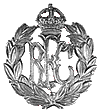
Lt. Colonel William Avery Bishop |

"In nearly all cases where machines have been downed, it was during a fight which had been very short, and the successful burst of fire had occurred within the space of a minute after the beginning of actual hostilities." William Bishop |
Bishop attended the Royal Military College before joining the
Canadian Mounted Rifles at the beginning of the war. In 1915, he transferred to the Royal
Flying Corps and received his pilot's certificate in 1917. "The Lone Hawk"
was considered by some to be a mediocre pilot, but his extraordinary eyesight and
consistent practice earned him a reputation as a crack shot. When the Germans placed a
price on his head, he had the spinner of his Nieuport 17 painted bright blue to make his
aircraft easier to identify. Bishop later scored a significant number of victories flying
the S.E.5A.
As the commanding officer of the "Flying Foxes," Bishop was awarded the
Distinguished Flying Cross (DFC) after he shot down 25 planes in only twelve days. Before the war
ended, he found time to write "Winged Warfare," an autobiographical
account of his exploits in the air over France. Bishop flew many of his patrols alone. Most of his victories were never witnessed. Through the years, controversy over his score led to an inquiry by the Canadian government after a television documentary challenged Bishop's claims. |
"For most conspicuous bravery, determination, and skill. Captain Bishop, who had been sent out to work independently, flew first of all to an enemy aerodrome; finding no machines about, he flew on to another aerodrome about 3 miles southeast, which was at least 12 miles the other side of the line. Seven machines, some with their engines running, were on the ground. He attacked these from about fifty feet, and a mechanic, who was starting one of the engines, was seen to fall. One of the machines got off the ground, but at a height of 60 feet, Captain Bishop fired 15 rounds into it at very close range, and it crashed to the ground. A second machine got off the ground, into which he fired 30 rounds at 150 yards range, and it fell into a tree. Two more machines then rose from the aerodrome. One of these he engaged at a height of 1,000 feet, emptying the rest of his drum of ammunition. This machine crashed 300 yards from the aerodrome, after which Captain Bishop emptied a whole drum into the fourth hostile machine, and then flew back to his station. Four hostile scouts were about 1,000 feet above him for about a mile of his return journey, but they would not attack. His machine was very badly shot about by machine-gun fire from the ground." VC citation, London Gazette, 11 August 1917 |
'Aces' home page | U. S. Fighter Home Page | Feedback